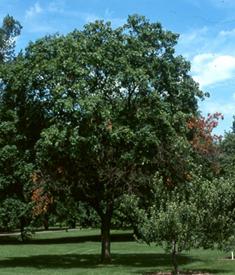

Verticillium wilt of maple.
|
|
| Severity: | 4 out of 5 |
| Frequency: | 3 out of 5 |
| Symptoms: | The plant symptoms that result when this disease attacks may be confused with premature fall defoliation and with other plant problems such as root rots as well as drought and damage due to excessive soil moisture. Plant leaves may curl, wilt, yellow or redden interveinally, die and defoliate. Individual branch die back may also be noticed. The disease starts in the roots and then progresses upward. As the vascular system becomes plugged due to the release tyloses or gums, the above-ground symptoms begin to appear. Internally, discoloration or streaking of the sapwood (xylem vascular tissue) occurs in most plants. The sapwood discoloration may appear as a striping of the wood when viewed on a branch with the bark peeled away. If the branch or plant is cut and the cross section examined, the discoloration may appear as a ring. The vascular discoloring often occurs with the advance of the fungus or the fungal spores through the sapwood except sometimes in the early stages of infection. Vascular discoloration varies with the host. In all ashes, internal discoloration is rare (occurs only about 5% o the time). In black locust the color is a dark reddish brown; it is a yellowish brown in cherry and smoke trees;and is a light- to dark-green in maple; magnolia and sumac. Although some plants may die quickly, more commonly it takes one or more years to die. Trees and shrubs with only a few wilted branches during a growing season may become more severely infected the following year. Some may recover and show no more symptoms in the following years. In other cases, the plant may develop symptoms several years later after the initial infection. |
| Cycle: | Both of these Verticillium species attack a wide range of plants besides woody ornamental trees and shrubs. Verticilium albo-atrum is adapted for the cooler soils in the world so is not usually found in tropical soils. Verticillium dahlia is more commonly found in most soils around the world. Even though V. albo-atrum is not as common as V. dahlia, it is more likely to be fatal to most plants. These two Verticillium species are root invaders. They do not live in the soil as saprophytic fungi but can survive in the soil for several years as specialized "structures". Infected dead root systems improve the survival of these fungi in the soil. These fungi are often moved with infected soil or plants. They invade stressed roots. Plants that are blooming or fruiting tend to be more susceptible. Cultural practices and environmental conditions can influence the infection of susceptible plants with these pathogens. The fungus enters plants through the root system and colonizes the water-conducting tissue (xylem) of susceptible hosts. Water transport becomes blocked by both fungal growth and gums and other substances that are part of the host defense system. Highly susceptible trees might die within one season, but in most cases dieback occurs over a few to several years. The fungus will remain in the soil for several years even if infected trees are removed. |
| Management: | Grow plants adapted to the site. Grow resistant varieties. Avoid root and collar injury. Keep plants vigorous. Trees and shrubs killed by Verticillium spp. should be removed with as much of the roots intact as possible. Plants showing early symptoms should be watered and fertilized. Use fertilizers lower in nitrogen and higher in potassium. Sterilize tools between pruning and removal of infected plants and pruning healthy plants. Allow several years (three or more) before growing a susceptible plant in an infected area. Do not plant back into the same hole! There are no proven cures (chemical or cultural) for this disease. |
| Associated shrubs: |
|